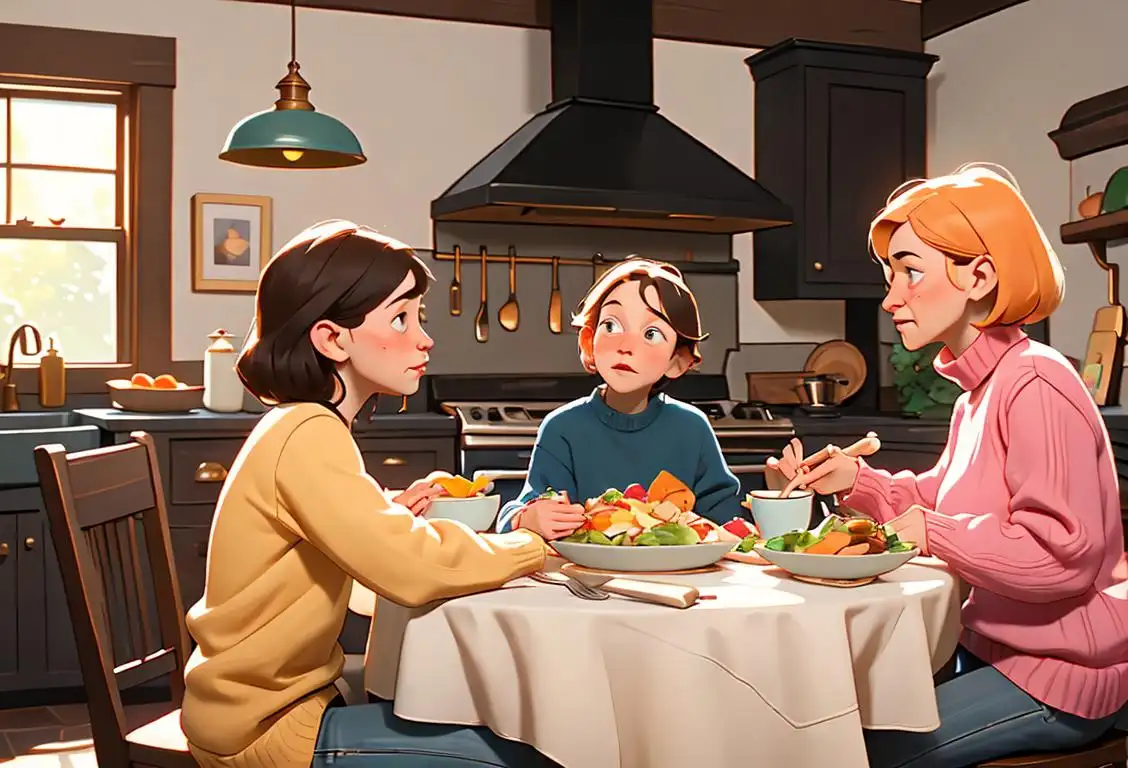National Leftovers Day

Ah, National Leftovers Day, the glorious day when we celebrate the art of repurposing yesterday's meals into today's delicious delights. It's the day that tells us it's perfectly acceptable to eat pie for breakfast and turkey sandwiches for dinner. So gather your loved ones, clear some space in the fridge, and let's dive into the wonderful world of leftovers!
When is Leftovers Day?
It's national leftovers day on the 27th November.
The Internet History of National Leftovers Day
Just like a good batch of leftovers, National Leftovers Day has its roots in the past. It all started in 2015 when the internet exploded with mentions and discussions about what to do with the abundance of post-Thanksgiving food.
Leftover enthusiasts across the web eagerly shared their creative recipes, from turkey soups to mashed potato pancakes. The idea of a dedicated day to celebrate the magic of leftovers quickly gained popularity, and thus, National Leftovers Day was born.
Since then, the day has become an annual tradition for many families and foodies. It's a time to experiment with new flavors, share favorite recipes, and bond over the shared experience of delicious excess.
Whether you're a culinary wizard turning leftover turkey into gourmet masterpieces or a microwave ninja who knows just the right buttons to press, National Leftovers Day offers endless possibilities for gastronomic adventure.
Leftovers: The Unsung Heroes of the Fridge
Did you know that leftovers have been saving hungry souls since the dawn of refrigeration? Back in the day, before the invention of refrigerators, people had to rely on various preservation methods to stretch their meals. From salting and smoking to pickling and fermenting, our ancestors way back when knew a thing or two about repurposing food.
Nowadays, we can just pop those delicious leftovers into the fridge and enjoy them the next day without any elaborate preservation methods. It's like having a personal kitchen time machine!
History behind the term 'Leftovers'
1811
The Invention of Refrigeration
In 1811, the first practical refrigeration machine was invented by John Gorrie, an American physician and scientist. This invention marked a significant milestone in preserving food for longer periods of time, preventing spoilage, and reducing wastage. The ability to keep food fresh for extended periods laid the groundwork for the concept of leftovers.
1762
The Birth of the Word
The term 'leftovers' first appeared in written language in 1762. It was used to describe the remains of a meal that were saved for later use or consumption. At this time, it primarily referred to the surplus food that was left over after a large feast or banquet. The concept of saving and reusing food dates back to ancient times, but it wasn't until the 18th century that the word 'leftovers' entered common use.
1850
The Emergence of 'Leavings'
By 1850, the term 'leavings' began to be used to refer to uneaten food that was saved for later consumption. This term reflected the idea of saving or leaving behind a portion of a meal to be eaten at a different time. It was during this period that leftovers started to enter the popular culinary lexicon.
1843
Cooking with Scraps
In 1843, a groundbreaking cookbook called 'Modern Cookery for Private Families' by Eliza Acton was published. This influential book not only contained a wealth of recipes, but it also popularized the idea of using leftovers creatively. Acton provided numerous suggestions for repurposing leftover food in new and inventive ways, such as transforming meat scraps into savory pies or turning stale bread into bread pudding. This marked a shift in perception, as leftovers were no longer seen as merely remnants to be discarded, but rather as valuable ingredients to be utilized in their own right.
1901
Mention of 'Leftovers' in Writing
In 1901, the term 'leftovers' was officially documented in writing for the first time. It appeared in 'The Century Dictionary and Cyclopedia,' defining leftovers as 'the remains of food, uneaten at the time it was prepared for a meal.' This marked the recognition of leftovers as a common concept in households and further popularized the term.
1881
Food Conservation during War
During times of war, food scarcity became a pressing issue. In 1881, during the Boer War, the British government introduced the concept of food conservation and encouraged households to minimize waste by making use of leftovers. Rationing and economic factors played a significant role in further popularizing the idea of utilizing leftovers to sustain families during difficult times. This mindset shift not only addressed immediate needs but also laid the foundation for sustainable practices that continue to this day.
1924
Refrigeration Revolution
With the widespread adoption of refrigeration technology in the 1920s, households gained the ability to store food for longer periods. This innovation had a profound impact on the concept of leftovers. As refrigerators became a common household appliance, leftovers could be stored safely, allowing families to stretch their meals over multiple days and reducing food waste. The convenience and accessibility of refrigeration further cemented the practice of saving and enjoying leftovers as a common part of daily life.
1940s
Aiding the War Effort
During World War II, rationing and food scarcity became major concerns. In an effort to conserve resources and support the war effort, leftovers gained increased significance. Individuals were encouraged to repurpose and utilize their leftover meals creatively. This period reinforced the importance of leftovers in minimizing waste and stretching limited food supplies.
1950s
The Rise of Convenience Culture
The 1950s marked the beginning of a rapid rise in convenience culture, with the proliferation of pre-packaged and processed foods. This shift led to an increase in leftovers as meals were often prepared in larger quantities than needed. With the rise of refrigeration and the advent of plastic food storage containers, leftovers became easier to store, reheat, and consume, gaining further prominence in everyday life.
Present Day
Leftovers as Culinary Delights
In the present day, leftovers have evolved from a practical necessity to a culinary art form. Creative chefs and home cooks around the world embrace the challenge of transforming leftovers into delicious and inventive dishes. From gourmet sandwiches made with yesterday's roast to flavorful soups crafted from vegetable scraps, leftovers are now celebrated for their potential to inspire culinary innovation. Additionally, the reduction of food waste has become a global concern, and the practice of utilizing leftovers aligns with sustainability goals and encourages mindful consumption.
Did you know?
Did you know that leftovers were once a sign of wealth and luxury? In the Middle Ages, having enough food to have leftovers meant that you were well-off and could afford to enjoy multiple meals. So when you're indulging in those leftover holiday treats, remember that you're carrying on a tradition fit for kings and queens!Tagged
romance food fun loved onesFirst identified
11th April 2015Most mentioned on
27th November 2015Total mentions
661Other days
Family Day
One Day
Awareness Day
Kissing Fried Chicken Day
Opposite Day
Vodka Boyfriend Day
Action Day
Happiness Day
Suicide Prevention Month Day
Believe Day









